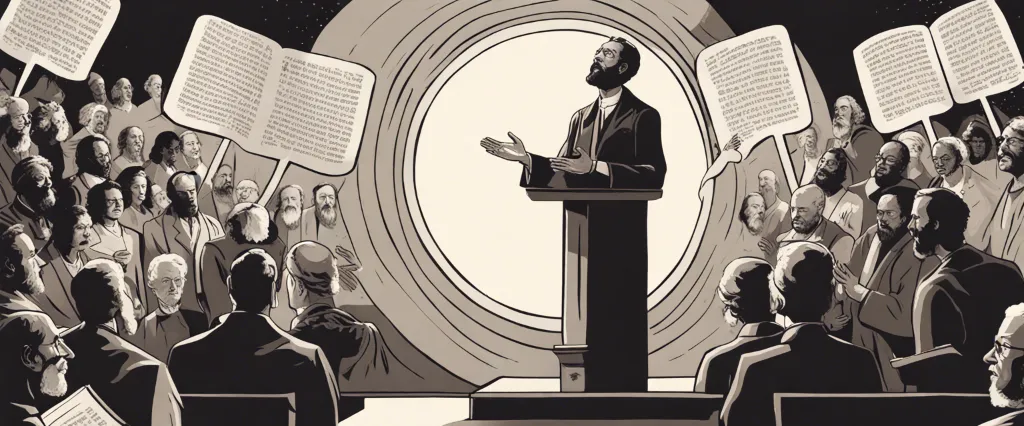
In the realm of public speaking and persuasive communication, two prominent and influential books have emerged as quintessential guides for improving presentations and delivering impactful messages. Nancy Duarte’s “Resonate” and Haddon W. Robinson’s “Biblical Preaching” stand as pillars in their respective genres – one focusing on visual storytelling and the other delving into the art of biblical sermons. While seemingly distinct, these two works ultimately share an underlying goal: to empower speakers with the tools necessary to captivate and resonate with their audiences. By analyzing and comparing the key principles, methodologies, and insights within “Resonate” and “Biblical Preaching,” we can uncover the similarities and divergences between the art of compelling communication within the realms of business and spirituality. Through an exploration of their distinctive approaches to form, content, and delivery, this comparative study aims to reveal the universal principles that lie at the core of effective public speaking. By examining these two influential texts side by side, we hope to extract valuable lessons that can be applied in a broader context, regardless of the speaker’s goals or the audience’s spiritual inclination.
Brief Summary of Two Books
Resonate by Nancy Duarte
Resonate by Nancy Duarte is a comprehensive guide that delves into the art of effective communication and presentations. Duarte, a renowned communication expert and author, explores the power of storytelling, visual design, and emotional connection to create compelling presentations that resonate with the audience.
The book begins by emphasizing the importance of understanding the audience and their desires, fears, and hopes. Duarte encourages presenters to view themselves as heroes who can bring about transformation through their ideas. She introduces the concept of the “Presentation Landscape” which outlines the journey a presenter must take the audience through, starting with the current reality and leading them to the desired new reality.
Duarte provides invaluable insights into the structure of a story, emphasizing the role of conflict and resolution. She advocates for the “sparkline,” a simple and compelling visual representation of the current and desired state, which helps presenters make a persuasive case for change. Throughout the book, she reinforces the importance of creating an emotional connection with the audience, using storytelling techniques, vivid language, and relatable examples.
The author also delves into the visual design aspect of presentations, emphasizing the use of clear and captivating visuals that support the message rather than overwhelming it. She offers practical tips for creating effective slides, including the use of contrast, repetition, and strategic movement.
Resonate is not just a how-to guide for creating impactful presentations, but also an exploration of the art of persuasive communication. Duarte’s book is filled with real-life examples from influential speeches, such as Martin Luther King Jr.’s “I Have a Dream” speech, making it a rich resource for anyone looking to captivate an audience and inspire action.
Biblical Preaching by Haddon W Robinson
“Biblical Preaching” by Haddon W. Robinson is a renowned guide for pastors, preachers, and aspiring ministers on how to effectively craft and deliver biblical sermons. Robinson addresses the key principles and strategies needed to communicate God’s message faithfully and convincingly in today’s world.
The book begins by emphasizing the importance of preaching that is rooted in the Scriptures, asserting that biblical preaching is not simply about sharing personal opinions or inspirational stories, but rather the proclamation of God’s Word. Robinson highlights the text-driven nature of effective sermons, teaching readers the significance of careful study, interpretation, and application of the biblical text.
Robinson then delves into the process of sermon preparation, providing practical advice on various stages, from selecting a passage to outlining the main points, developing illustrations, and delivering the message. He stresses the importance of crafting sermons that engage the audience intellectually, emotionally, and spiritually, capturing their attention and leading them to encounter the truths of Scripture.
Furthermore, Robinson explores the art of effective communication, teaching readers how to use language, voice, and body language to enhance the delivery of the message. He emphasizes the need for clarity, simplicity, and authenticity in preaching, urging pastors to connect with their congregations on a personal level.
Throughout the book, Robinson encourages preachers to remember the ultimate purpose of their calling: to transform lives and draw people to a closer relationship with God. He challenges readers to avoid the pitfalls of legalistic preaching or attempting to impress with eloquence, instead urging them to focus on God’s message and let it speak with power and relevance.
In summary, “Biblical Preaching” is a comprehensive resource that equips pastors and preachers with the tools, insights, and principles needed to effectively communicate the Word of God. It guides readers in developing sermons that are rooted in the Scriptures, intellectually engaging, and spiritually transformative, encouraging preachers to faithfully proclaim the timeless truths of the Bible in a way that resonates with contemporary audiences.
Comparison between Two Books

Similarities in Public Speaking
Both “Resonate” by Nancy Duarte and “Biblical Preaching” by Haddon W. Robinson cover the topic of public speaking, albeit in different contexts. Despite the varying subject matter, there are several similarities in the approach to public speaking presented in these books:
1. Understanding the audience: Both books emphasize the importance of knowing one’s audience and tailoring the message accordingly. Whether it’s addressing a business audience or delivering a sermon, the speakers need to understand the needs, expectations, and background of their listeners to effectively engage them.
2. Storytelling: Duarte and Robinson both advocate for the power of storytelling in public speaking. They suggest that stories capture the attention and emotions of the audience, making the message more memorable and relatable. Both authors provide techniques and examples to effectively incorporate narratives into speeches.
3. Visual aids: Both books highlight the significance of visual aids in enhancing the impact of a speech. Duarte’s “Resonate” focuses extensively on creating visually engaging slide decks, whereas Robinson’s “Biblical Preaching” includes suggestions for using props or visual aids to reinforce the message. Both authors stress the need for visual elements to complement the spoken words and reinforce key points.
4. Structure and organization: Duarte and Robinson emphasize the importance of structuring speeches in a way that guides the audience through a logical and engaging flow. Both books provide frameworks and strategies for organizing ideas, building suspense, and maintaining a consistent structure to prevent listener disengagement.
5. Delivery techniques: Both authors delve into the techniques of effective delivery while speaking to an audience. They discuss aspects such as vocal modulation, body language, timing, and the use of pauses to add emphasis and impact. Both books aim to equip speakers with the tools needed to enhance their delivery skills and captivate their audience.
These similarities demonstrate that regardless of the context, whether it’s secular or faith-based speaking, the principles of effective public speaking remain fundamentally the same. Understanding the audience, storytelling, using visual aids, maintaining structure, and refining delivery techniques are all crucial elements in captivating and resonating with an audience.
Divergences in Public Speaking
Resonate by Nancy Duarte and Biblical Preaching by Haddon W Robinson both focus on the art of public speaking but from different perspectives, targeting different audiences. While they share some similarities, there are key divergences in their approaches.
1. Audience-Centric vs. Message-Centric:
Resonate by Nancy Duarte emphasizes understanding and connecting with the audience. Duarte believes that effective communication requires identifying the needs, aspirations, and beliefs of the audience and tailoring the message accordingly to resonate with them emotionally. On the other hand, Biblical Preaching by Haddon W. Robinson places more importance on the message itself, asserting that effective preaching should uphold the biblical text accurately and remain true to its theological principles.
2. Use of Visuals and Storytelling:
Nancy Duarte in Resonate employs the use of visuals, such as slides and images, to enhance the impact of a presentation. She emphasizes that words alone are not enough but need visual representation to create a lasting impression. Duarte also highlights the power of storytelling in engaging the audience and illustrating concepts effectively. In contrast, Haddon W. Robinson in Biblical Preaching focuses less on visual aids and more on the power of oral communication and the use of persuasive language in conveying the message.
3. Secular versus Spiritual Context:
Resonate is primarily geared towards secular public speaking contexts such as business presentations, keynote speeches, and TED talks. Nancy Duarte draws inspiration from various sources, including famous speeches, movies, and art, to offer practical insights for speaking in a secular setting. In contrast, Biblical Preaching is centered explicitly in the spiritual realm, aiming to equip preachers with effective methods for delivering sermons rooted in biblical truth and theological principles.
4. Structure and Organization:
Both books emphasize the importance of structure and organization in a speech. However, Resonate by Nancy Duarte offers a more flexible and adaptable approach to structuring presentations, citing various models that can be applied based on the context or message being delivered. Biblical Preaching by Haddon W. Robinson, while acknowledging the need for adaptation, provides a more comprehensive framework specifically for sermon preparation and delivery, focusing on essential elements such as textual, contextual, and theological analysis.
Overall, while Resonate by Nancy Duarte and Biblical Preaching by Haddon W. Robinson share some common ground in their understanding of core principles of public speaking, they diverge in terms of focus, audience, use of visuals, and the overall context of their teachings.

Conclusion
Both “Resonate” by Nancy Duarte and “Biblical Preaching” by Haddon W. Robinson are highly regarded books in their respective fields. Ultimately, which book is more worthy of reading depends on your interests and needs.
“Resonate” by Nancy Duarte is a book that focuses on the art of effective visual storytelling and presentation design. It delves into the principles of creating impactful presentations that resonate with the audience. If you are interested in improving your communication skills, especially in the realm of presentations, this book would be highly valuable.
On the other hand, “Biblical Preaching” by Haddon W. Robinson is a book geared towards those involved in or interested in religious sermons and preaching. It explores the nuances and techniques of biblical preaching, providing insights and practical guidance for delivering engaging and effective sermons.
Therefore, if you are interested in the field of communication, storytelling, and presentation design, “Resonate” would be more valuable. However, if you are looking to enhance your understanding and approach to biblical preaching, “Biblical Preaching” would be the better choice.
Ultimately, it is essential to consider your specific interests and goals to determine which book aligns better with your needs.


